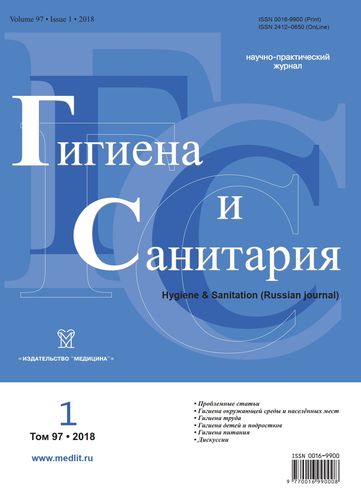Analysis of the effectiveness of technologies for correcting disorders of the physical development in children living in low-level atmospheric air pollution and drinking water with metals (lead, manganese, nickel, chromium, cadmium)
- Authors: Luzhetsky K.P.1, Ustinova O.Y.1, Goleva O.I.1,2, Shtina I.E.1
-
Affiliations:
- Federal Scientific Center for Medical and Preventive Health Risk Management Technologies
- Perm State National Research University
- Issue: Vol 97, No 1 (2018)
- Pages: 75-81
- Section: HYGIENE OF CHILDREN AND ADOLESCENTS
- Published: 14.10.2020
- URL: https://ruspoj.com/0016-9900/article/view/640362
- DOI: https://doi.org/10.47470/0016-9900-2018-97-1-75-81
- ID: 640362
Cite item
Full Text
Abstract
In the course of studying the impact of metal compounds on the functioning of the endocrine system and adaptation systems in children living in chronic low-level multi-environmental (atmospheric air, drinking water) effects of a complex of metals, the elevated content of lead, manganese, nickel, cadmium and chromium was established to be 1.5–9.4 times higher than the reference level and 1.3–2.2 times than indices of the comparison group). In this contingent, disorders of the physical development and malnutrition (ICD: E44-46) were detected by 1.2–1.7 times more often than in conditions of sanitary and hygienic well-being. In the course of the analysis of the effectiveness of methods of correction in children of physical development disorders and malnutrition (E44-46) associated with the effects of metals, there was shown the high efficiency of the complex application of elimination, membrane stabilizing, antioxidant and nootropic technologies, with methods of physiotherapy (Ultrasound therapy, inductothermy) and exercise therapy. With comparable economic costs with traditional approaches, the proposed correction technologies demonstrate a significant benefit (up to 3.3 times) for the economy of the country and the region. The prevented losses for Gross Domestic Product (GDP) for the observation group are 13246.0 rubles per person per year (2.25 rubles per 1 ruble of costs, in contrast to 0.7 rubles when using standard methods).
About the authors
Konstantin P. Luzhetsky
Federal Scientific Center for Medical and Preventive Health Risk Management Technologies
Author for correspondence.
Email: nemo@fcrisk.ru
MD, PhD, DSci., head of the Clinic of occupational pathology and labor medicine of the Federal Scientific Center for Medical and Preventive Health Risk Management Technologies, Perm, 614015, Russian Federation.
e-mail: nemo@fcrisk.ru
Russian FederationO. Yu. Ustinova
Federal Scientific Center for Medical and Preventive Health Risk Management Technologies
Email: noemail@neicon.ru
Russian Federation
O. I. Goleva
Federal Scientific Center for Medical and Preventive Health Risk Management Technologies; Perm State National Research University
Email: noemail@neicon.ru
Russian Federation
I. E. Shtina
Federal Scientific Center for Medical and Preventive Health Risk Management Technologies
Email: noemail@neicon.ru
Russian Federation
References
- Boev V.M., Boev M.V., Tulina L.M., Neplokhov A.A. Determined ecological human health risk factors in single factory towns. Analiz riska zdorov’yu. 2013; (2): 39-44. (in Russian)
- Korochkina Yu.V., Perekusikhin M.V., Vasil’ev V.V., Panteleev G.V. Hygienic environmental assessment and health of children in Penza. Analiz riska zdorov’yu. 2015; (3): 33-9. (in Russian)
- Bukharova E.M. Influence of urban factors on the physical development and health of children. Zdravookhranenie Rossiyskoy Federatsii. 2011; 57(5): 18. (in Russian)
- Grigor’ev Yu.I., Ershov A.V., Silin I.I. Air quality and childhood morbidity. Gigiena i sanitariya. 2010; 89(4): 28-31. (in Russian)
- Kuchma V.R. Hygiene of Children and Adolescents [Gigiena detey i podrostkov]. Moscow: GEOTAR-Media; 2008. (in Russian)
- Sergeev O.V., Speranskaya O.A. Substances that Disrupt the Endocrine System: Status and Possible Directions of Work [Veshchestva, narushayushchie rabotu endokrinnoy sistemy: sostoyanie problemy i vozmozhnye napravleniya raboty]. Samara: As Gard; 2014. (in Russian)
- Gil’denskiol’d R.S., Novikov Yu.V., Khamidulin R.S., Aniskina R.I., Vinokur I.L. Heavy metals in environment and their impact on a body. Gigiena i sanitariya. 1992; 71(5-6): 6-9. (in Russian)
- Korchina T.Ya., Korchin V.I. Comparative characteristics of lead and cadmium intoxication in the Khanty-Mansi Autonomous District. Gigiena i sanitariya. 2011; 90(2): 8-10. (in Russian)
- Luzhetskiy K.P. Hygienic assessment of the impact of natural and anthropogenic chemical factors on the development of iodine deficiency diseases in children and the improvement of preventive: Diss. Perm’; 2010. (in Russian)
- Vandysheva A.Yu., Luzhetskiy K.P., Ustinova O.Yu., Shcherbakov A.A. Rates of the biological maturation and particularities of violation of the locomotor system in children under conditions of oral exposure to strontium in drinking water. Zdorov’e naseleniya i sreda obitaniya. 2015; (12): 45-7. (in Russian)
- Zaitseva N.V., Ulanova T.S., Plakhova L.V., Suetina G.N Influence of multimetallic pollution of environmental objects on changes in the trace element composition of the biological media in children. Gigiena i sanitariya. 2004; 83(4): 11-5. (in Russian)
- Abramova N.A., Fadeev V.V., Gerasimov G.A., Mel’nichenko G.A. Environmental Goitrogens and Goitrogenic Factors. Klinicheskaya i eksperimental’naya tireoidologiya. 2006; 2(1): 21-32. (in Russian)
- Lanin D.V. Тhe analysis of the co-regulation between the immune and neuroendocrine systems under exposure to risk factors. Analiz riska zdorov’yu. 2013; (1): 73-81. (in Russian)
- Ustinova O.Yu., Zaytseva N.V., Permyakov I.A., Vandysheva A.Yu., Verikhov B.V. The influence of manganese on bone metabolism of the children residing in the conditions of the influence of chemical factors of the environment. Fundamental’nye issledovaniya. 2011; (9): 314-7. (in Russian)
- Aminova A.I., Ustinova O.Yu., Luzhetskiy K.P., Maklakova O.A. Prevention technologies ecobulletin of allergic respiratory diseases in children in preschool institutions. Mezhdunarodnyy zhurnal prikladnykh i fundamental’nykh issledovaniy. 2011; (5): 86-7. (in Russian)
- Shtina I.E., Luzhetskiy K.P., Ustinova O.Yu. Assessment of the effectiveness of preventing physical development and malnutrition (E44-46) associated with the effects of metals (lead, manganese, nickel, cadmium, chromium) in children. Zdorov’e naseleniya i sreda obitaniya. 2017; (4): 38-42. (in Russian)
- Vorontsov I.M., Mazurin A.V. Propedeutics of Childhood Diseases [Propedevtika detskikh bolezney]. St. Petersburg: Foliant; 2009. (in Russian)
- Reference data. Metod analiza ICP-MS, 1999-2001g. ALS Skandinavia. Available at: https://www.alsglobal.se/mediae/pdf/reference_data_biomonitoring_120710.pdf
- MR 01-19/31-17. Methodical recommendations for assessing the physical development and health status of children and adolescents, studying the medical and social reasons for the formation of deviations in health. Moscow; 1996. (in Russian)
- Tits N.U. Clinical Guidelines for Laboratory Tests: Guidelines [Klinicheskoe rukovodstvo po laboratornym testam: rukovodstvo]. Moscow: YUNIMED-press; 2003. (in Russian)
- Glantz S.A. Primer of Biostatistics. New-York: McGraw-Hill; 1994.
Supplementary files









